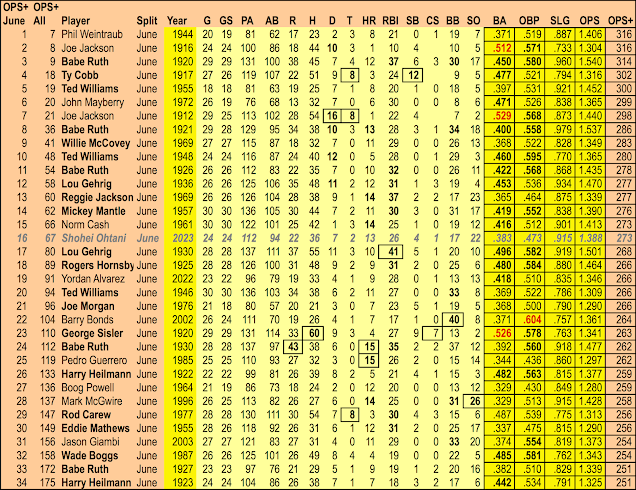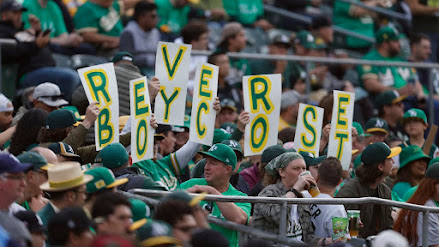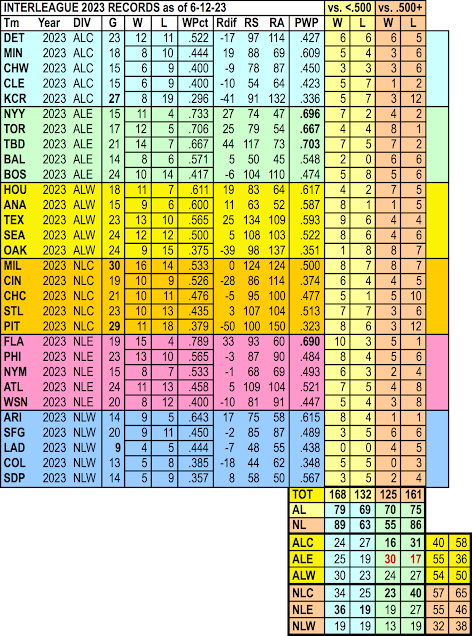LAST night was a singular event in baseball history, when a ravaged and often reviled fan base turned the other cheek, crafting a ragamuffin miracle from the dross of corporate greed and unending chicanery. Long-suffering lovers of the Oakland A's banded together in a celebration that doubled as a devastating critique of baseball's ongoing duplicity regarding the fate of a franchise that has always been unlucky enough to be in something akin to wayward hands.
With their team stripped down into a tattered facsimile of the "less is more" miracles performed by
Billy Beane for so many years until an unusually reptilian ownership group opened a trap door that plunged the team into a freefall equally only by a similar corporate chicanery that befell the Cleveland Spiders in 1899 (prime time for those we now all call "robber barons," natch), the fans who'd boycotted the unseemly fate of their team as it seemingly marched toward the worst won-loss record in baseball history suddenly performed an astonishing volte-face, staging a brilliant, spontaneous, and utterly inspired "reverse boycott." The result was a night for the ages that may not have silenced all of the professional cynics, or have swayed the game's gatekeepers, but that resonated in ways that may yet surface into the discussion of a more equitable future for a game and business still desperately in need of self-healing.
For more details of this singular event, you're directed to the brilliant article at The Athletic by Melissa Lockard, which gives full voice to the organizers and sensitively walks a fine line in the world of "objective reporting" to provide an indelible picture of the emotional atmosphere that surrounded the evening. Lockard, clearly swayed by what she witnessed, wisely allows the quotes from the event's organizers to do the heavy lifting in making clear that this was both a protest and a love-in, a clarion call to the feckless money-changers who seek to control not only the vertical and the horizontal, but the diagaonal as well--a defiant but loving plea for community over "crack-up capitalism." Its chances of turning the tide may well be slim, but the message is both of its time and one for the ages: man (and baseball) cannot live by spreadsheets alone. The people matter.
Barely mentioned in Lockard's article, however, is the equally astonishing fact that the ballclub itself is making some exceptionally anomalous rumblings for one that lost 46 of its first 56 games. After being called the "worst team ever seen" by some ostensibly qualified insiders, the rag-tag team has gotten off the deck and done something that no one in anything approach their right mind could have predicted: with a thrilling, highly emotional 2-1 win against their often-mentioned-in-the-same-breath opponents, the high-fling Tampa Bay Rays, the A's won their seventh game in a row and, for one night at least, climbed out of 30th place in the standings (passing the lowly, forlorn Kansas City Royals by percentage points).

THE rumblings had started nearly two weeks ago, when the A's pitching--simply execrable for the first two months of the 2023 season--suddenly rose from the dead and contributed significantly to two wins against the first-place Atlanta Braves. After a loss on the final day of May, the A's next road trip seemingly returned them to their "dead man walking" modus operandi, with three losses in Miami and a typical defeat-snatched-from victory affair in their opening game in Pittsburgh.
But then there were two wins against the Pirates, including an improbable 11-2 rout catalyzed by professional castoff Jace Peterson (5 hits, 2 HR, 5 RBI) The next day, the entire A's lineup came alive, with every starter getting at least one hit en route to a 17-hit game punctuated by a seven-run first inning, raising eyebrows across the mediascape (including the time-honored quip from waggish wags that such reports must be erroneous).
And then in Milwaukee, the strange goings-on kept going on, as the A's swept the Brewers (rising up, for some of us at least, against the hoary ghost of Budzilla), making canny use of the "opener" in the first game to calm the often jangled nerves of struggling starter Luis Medina, getting a fine start from their recently returned 2022 All-Star representative Paul Blackburn in the second game, and smacking clutch homers and riding the rollercoaster with a still-shaky bullpen to bring home their fifth win in a row (final score: 8-6), making them the most anomalous ultra-bad team in baseball history.
SO now to our buried lede--the "a-nomalous A's." Research all of the truly bad teams in baseball history, and you will find a total dearth of "winning streaks." Now that may seem inordinately obvious, of course, since it's hard to win a lot of games in a row when you're not winning any games at all. Nonetheless, it's instructive than none of the worst teams in baseball history had ever won more than five games in a row during their "crash-and-burn seasons." Here's a quick survey, from the very worst of the worst to the awfully worse:
1916 PHILADELPHIA A's (36-117): Never won three games in a row. Won two games in a row five times. From May 31 through August 8, posted a 5-58 record (.079).
1935 BOSTON BRAVES (38-115): Won four games in a row once. Won three games in a row twice.
1962 NEW YORK METS (40-120): Won three games in a row twice.
1904 WASHINGTON SENATORS (38-113): Won three games in a row once. Won two games in a row four times. Started the season 0-13-1.
2003 DETROIT TIGERS (43-119): Won four games in a row once. Won three games in a row four times. (Wins in streaks represented nearly 40% of their total wins for the season.)
1952 PITTSBURGH PIRATES (42-112): Never won three games in a row. Won two games in a row eight times. Had one stretch in the season (June 10-19) where they played .500 ball over ten games.
1939 ST. LOUIS BROWNS (43-111): Never won three games in a row. Won two games in a row nine times. Played .500 ball over one ten-game stretch (September 10-17).
1941 PHILADELPHIA PHILLIES (43-111): Won three games in a row twice.
2018 BALTIMORE ORIOLES (47-115): Won four games in a row once. Won three games in a row twice.
2019 DETROIT TIGERS (47-114): Won five games in a row once--April 2-7 (known in the world of baseball--and elsewhere-as "shooting your wad early"). Won three games in a row twice (but never after May). (Went 10-40 from June 1-July 31.)
There you have it. Ten truly terrible teams, and amongst the wreckage there we find one five-game win streak, three four-game winning streaks, and fifteen three-game winning streaks.
And then there are these anomalous A's, cruising to join the infamously damned, soon (apparently) to be banished to America's analogue of the City of Mahagonny, who, via some collectively unconscious force of will, defy the odds and high-wire-walk their way into a five-game winning streak. Surely it will all come to an end when they arrive home and have a four-game series with the Rays, right? The team with the best record in baseball, the team that eviscerated them in April, outscoring them 29-5 over the three games?
But somehow, some way, it doesn't come to an end. The A's Rule 5 offseason pickup, first baseman Ryan Noda, caps a four-run fifth inning against the Rays' Zac Eflin (8-1 coming into the game); they survive a three-run counterblast from Jose Siri in the sixth, and embattled lefty Ken Waldichuk, pulled from the A's collective wreckage of a starting rotation after posting an unsightly 7.43 ERA, closes out the game with three shutout innings of relief, striking out five and recording the first save of his career.
At which point the A's truly became anomalous...but then there was the serendipitous timing of the "reverse boycott," which brought in the largest crowd of the year, a crowd revved up by an inchoate but palpable
amor fati which randomly aligned with a 26-man crew trying with all their might to salvage their wrecked vessel and give it a chance to sail home with body and soul intact.
Serendipity took note, and gave the A's several needed boosts in another tense, one-run game (and these anomalous A's have been surprisingly good in such games, even as they were also shot down from the trees in so many blowouts during April and May). In the ninth inning, fledgling closer Trevor May was wild, but catcher Shea Langeliers made an immaculate throw that just beat the Rays' fleet Randy Arozarena to second base; the play was contested by Tampa, but the ruling held. The dangerous Siri then batted, representing the go-ahead run for the Rays, but May, perhaps sensing his moment, found the plate and made quick work of the quixotic slugger, striking him out on three pitches to put the finishing touches on the dual "reverse boycott" that the team and the fans had welded together.
So--seven wins in a row, representing 37% of the A's total number of wins thus far in this season of surrealism. Will the A's win all of the rest of their games in '23, as the
Tango Love Pie™ facetiously suggested over at Twitter? Of course not. Will their uplift turn quickly into subsidence? Maybe. After all, if they turn into a "merely bad" team, that would be anti-climactic in a world that seems to crave apocalypse, spectacle, reality TV and rogue politicians. It's likely best to savor the anomaly for what it tells us about life in an increasingly benighted world, and the potential that exists for that world to save itself from its own greed and self-destruction.
Give the A's their due: they've done something that no team in their position has ever done before--and no matter what happens from this point forward, they've done something that all of us should aspire to--they've reclaimed their dignity. More power to them--and maybe if we think and wish and hope and pray, the A's and Oakland will be saved from their feckless "blue jean heir" owner. Chances are slim, but 'tis still a consummation devoutly to be wished. Stay tuned...




















